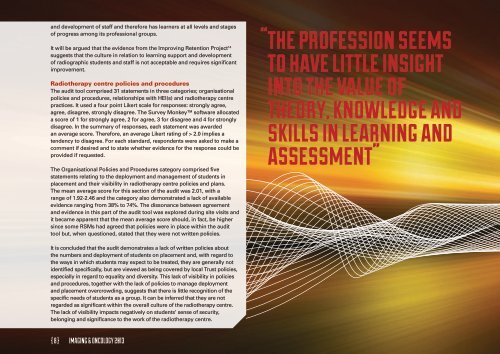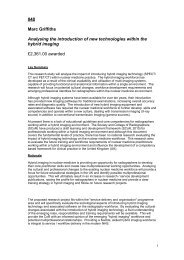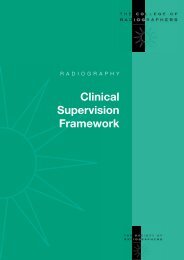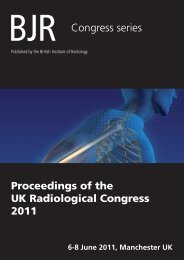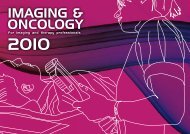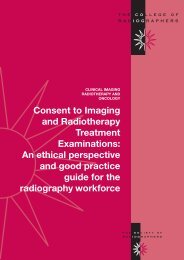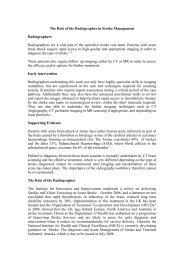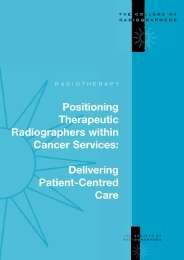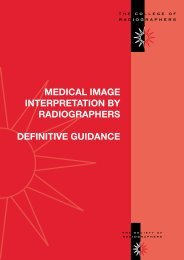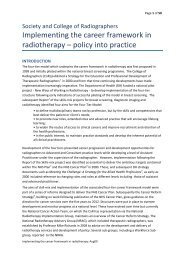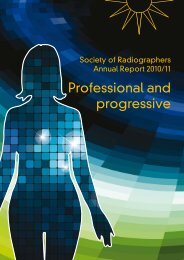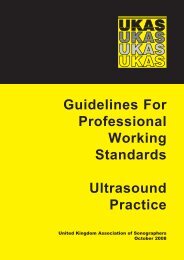Imaging & Oncology - Society of Radiographers
Imaging & Oncology - Society of Radiographers
Imaging & Oncology - Society of Radiographers
Create successful ePaper yourself
Turn your PDF publications into a flip-book with our unique Google optimized e-Paper software.
and development <strong>of</strong> staff and therefore has learners at all levels and stages<br />
<strong>of</strong> progress among its pr<strong>of</strong>essional groups.<br />
It will be argued that the evidence from the Improving Retention Project 14<br />
suggests that the culture in relation to learning support and development<br />
<strong>of</strong> radiographic students and staff is not acceptable and requires significant<br />
improvement.<br />
Radiotherapy centre policies and procedures<br />
The audit tool comprised 31 statements in three categories; organisational<br />
policies and procedures, relationships with HEI(s) and radiotherapy centre<br />
practices. It used a four point Likert scale for responses: strongly agree,<br />
agree, disagree, strongly disagree. The Survey Monkey s<strong>of</strong>tware allocated<br />
a score <strong>of</strong> 1 for strongly agree, 2 for agree, 3 for disagree and 4 for strongly<br />
disagree. In the summary <strong>of</strong> responses, each statement was awarded<br />
an average score. Therefore, an average Likert rating <strong>of</strong> > 2.0 implies a<br />
tendency to disagree. For each standard, respondents were asked to make a<br />
comment if desired and to state whether evidence for the response could be<br />
provided if requested.<br />
The Organisational Policies and Procedures category comprised five<br />
statements relating to the deployment and management <strong>of</strong> students in<br />
placement and their visibility in radiotherapy centre policies and plans.<br />
The mean average score for this section <strong>of</strong> the audit was 2.01, with a<br />
range <strong>of</strong> 1.92-2.46 and the category also demonstrated a lack <strong>of</strong> available<br />
evidence ranging from 38% to 74%. The dissonance between agreement<br />
and evidence in this part <strong>of</strong> the audit tool was explored during site visits and<br />
it became apparent that the mean average score should, in fact, be higher<br />
since some RSMs had agreed that policies were in place within the audit<br />
tool but, when questioned, stated that they were not written policies.<br />
“the pr<strong>of</strong>ession seems<br />
to have little insight<br />
into the value <strong>of</strong><br />
theory, knowledge and<br />
skills in learning and<br />
assessment”<br />
It is concluded that the audit demonstrates a lack <strong>of</strong> written policies about<br />
the numbers and deployment <strong>of</strong> students on placement and, with regard to<br />
the ways in which students may expect to be treated, they are generally not<br />
identified specifically, but are viewed as being covered by local Trust policies,<br />
especially in regard to equality and diversity. This lack <strong>of</strong> visibility in policies<br />
and procedures, together with the lack <strong>of</strong> policies to manage deployment<br />
and placement overcrowding, suggests that there is little recognition <strong>of</strong> the<br />
specific needs <strong>of</strong> students as a group. It can be inferred that they are not<br />
regarded as significant within the overall culture <strong>of</strong> the radiotherapy centre.<br />
The lack <strong>of</strong> visibility impacts negatively on students’ sense <strong>of</strong> security,<br />
belonging and significance to the work <strong>of</strong> the radiotherapy centre.<br />
{ 8 } IMAGING & ONCOLOGY 2013


